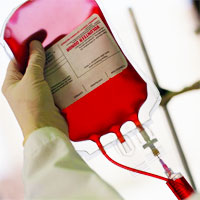Tag: septic shock

Resuscitating Sepsis – How I do it after Albios
Watch "Resuscitating Sepsis - How I do it after Albios" by Luciano Gattinoni.... read more

Evaluating Transfusion Strategies
Cancer patients are at increased risk of septic shock. Therefore, Bergamin et al set out to assess whether a restrictive strategy of red blood cell (RBC) transfusion reduces 28-day mortality when compared with a liberal strategy... read more

COPD can increase risk of developing sepsis
People with COPD have a higher than average risk of developing lung infections, such as pneumonia, which then puts them at higher risk for developing sepsis. Sepsis and septic shock can result from an infection anywhere in... read more

Sepsis E-alert System with Response Team Improves Outcomes
According to a new study, the use of a multifaceted intervention including an electronic sepsis alert (e-alert) system with sepsis response team was associated with improvement in care processes of sepsis and septic shock... read more

Potential survival benefit of polymyxin B hemoperfusion in patients with septic shock
The purpose of this study was to investigate whether polymyxin B hemoperfusion (PMX-HP) improves the survival of patients with septic shock. Our results strongly suggest that PMX-HP reduces all-cause hospital mortality and... read more

Management of Septic Shock
The results of the PRISM trials confirm that early intervention strategies, including early detection of sepsis, risk stratification, early administration of antibiotics, and appropriate fluid resuscitation, improve the outcomes... read more

Clinical Practice Parameters for Hemodynamic Support of Pediatric and Neonatal Septic Shock
The American College of Critical Care Medicine provided 2002 and 2007 guidelines for hemodynamic support of newborn and pediatric septic shock. Provide the 2014 update of the 2007 American College of Critical Care Medicine... read more

Serial Procalcitonin Predicts Mortality in Severe Sepsis Patients
Objectives: To prospectively validate that the inability to decrease procalcitonin levels by more than 80% between baseline and day 4 is associated with increased 28-day all-cause mortality in a large sepsis patient population... read more

Fluid resuscitation in human sepsis: Time to rewrite history
Fluid resuscitation continues to be recommended as the first-line resuscitative therapy for all patients with severe sepsis and septic shock. The current acceptance of the therapy is based in part on long history and familiarity... read more

Evaluating the Validity of Sepsis-3 Criteria in the Emergency Department
In this multicenter prospective cohort study involving 879 patients with suspected infection treated at the emergency department, the qSOFA was better at predicting in-hospital mortality with an area under the receiver operating... read more

Venous congestion: are we adding insult to kidney injury in sepsis?
In critical illness, septic shock is a contributing factor in nearly half of all cases of acute kidney injury (AKI). Traditional approaches to prevention of organ dysfunction in early sepsis have focused on prevention of... read more

The impact of emergency department crowding on early interventions and mortality in patients with severe sepsis
Critically ill patients require significant time and care coordination in the emergency department (ED). We hypothesized that ED crowding would delay time to intravenous fluids and antibiotics, decrease utilization of protocolized... read more

Relative Bradycardia in Patients With Septic Shock Requiring
Relative bradycardia in patients with septic shock is associated with lower mortality, even after adjustment for confounding. Our data support expanded investigation into whether inducing relative bradycardia will benefit... read more

Early, Goal-Directed Therapy for Septic Shock
After a single-center trial and observational studies suggesting that early, goal-directed therapy (EGDT) reduced mortality from septic shock, three multicenter trials (ProCESS, ARISE, and ProMISe) showed no benefit. This... read more






